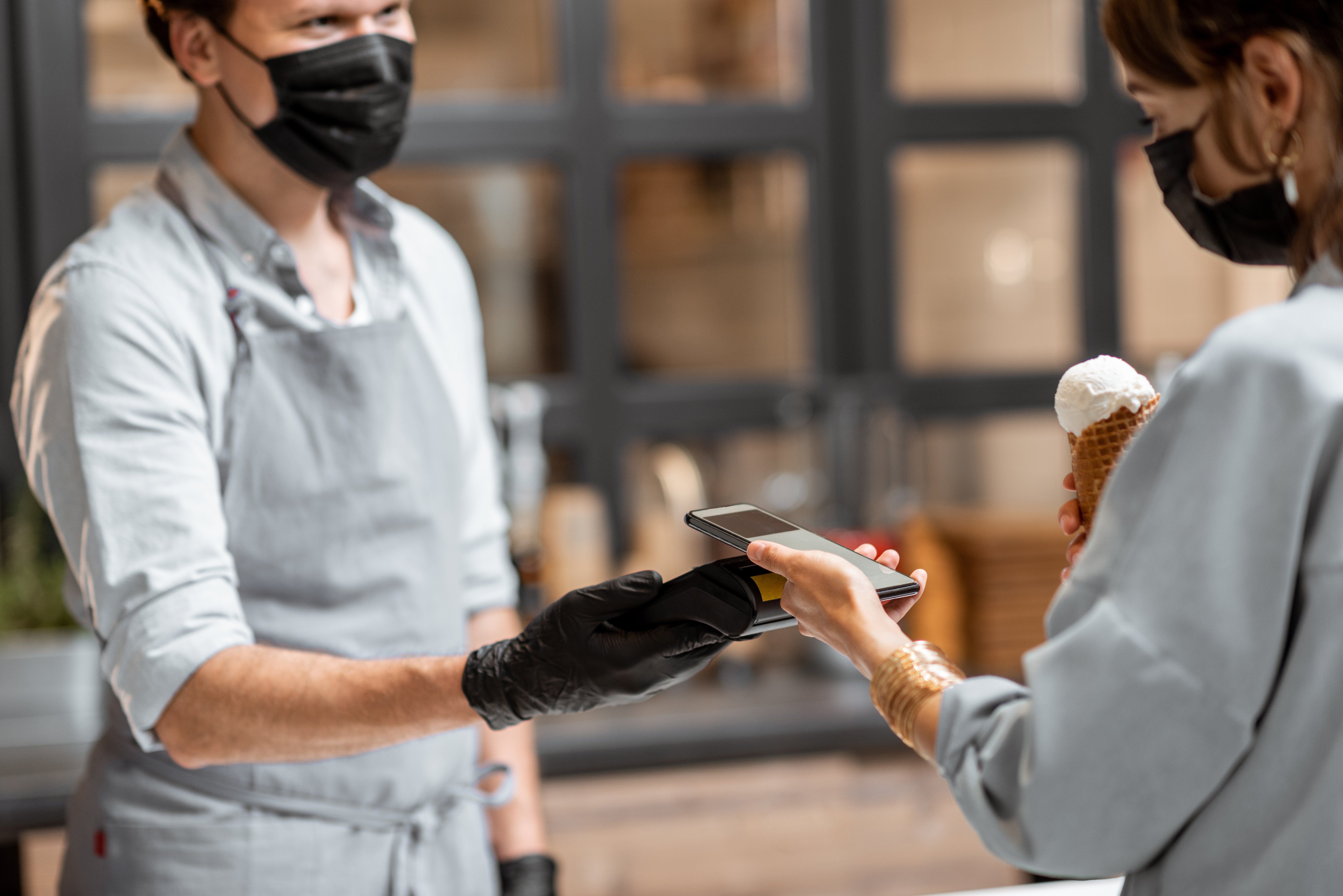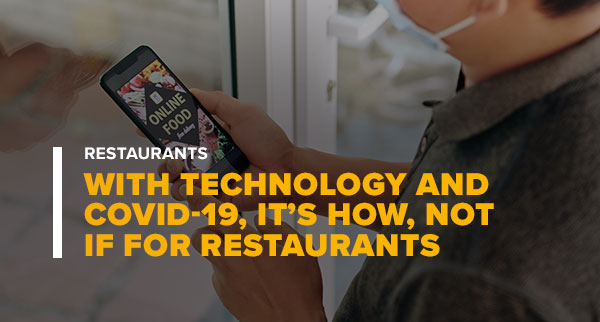December 2020 - By Danny Klein - Published in QSR Magazine - A former Red Robin executive on where to begin with tech, and what the end result might just look like. - Technology was a muddled and complicated arena for restaurants before COVID-19. But you generally had two choices—embrace or avoid. That’s not so much the case today. What is still valid, however, is trying to understand what fits and what doesn’t, and which paths to implementation represent the best strategy. Early on during the pandemic, operators dove just to dive, or because they had no choice. Yet on the doorstep of winter, with cases surging and no letup in sight, refining digital infrastructure becomes key. As the novelty of offering new options fades and the pool grows deeper, differentiation becomes the aim once again.
Dave Gates, the VP of restaurant development at UniFocus, who previously spent 27 years at full-service burger chain Red Robin, chatted with QSR about the biggest tech trends today and how restaurants are levering them in a COVID environment, as well as what comes next.
Tell us a little bit about your background and how you ended up at UniFocus
Well, I first started my career at Red Robin and spent 28 years there rising through the company ranks. I started as a line cook and eventually worked my way up to the Vice President of Operations level. My final role was the VP of Enterprise Transformation, where I focused on finding opportunities to improve the delivery of our brand’s promise to team members, guests and shareholders. As an executive, I primarily oversaw Red Robin’s continuous improvement and initiatives while implementing advanced technologies into various aspects of business operations. From 2009 to 2015, we opened 125 restaurants and increased operating margins by more than 400 basis points to save over $425 million in profit.
After Red Robin, I partnered with large foodservice companies as a consultant to help improve performance through superior customer service, reduced operational costs and higher generated ROIs. I first met UniFocus in 2010, when Red Robin chose to partner with them for our labor management solution. In July 2020, I was hired as their Senior VP of Restaurant Development to support their growth initiatives. I’ve known the UniFocus leadership team and platform for a long time, so it was a natural fit for me. In my view, UniFocus is the most effective workforce optimization system on the market. I joined to help further integrate it into the restaurant industry.
Let’s jump into the technology conversation. As we’ve seen over the past eight or so months, brands are pivoting quicker than ever. But what are some pitfalls you’ve seen? What kind of things should restaurants, especially those trying new platforms, make sure they cross off before taking the leap?
It’s a very complex scenario. First off, many restaurants are in different life cycles depending on the technology they were using before the pandemic. Some restaurants were already early adopters of third-party delivery services, while others were already leveraging diverse tech stacks. So every situation is a little different. There obviously has been a spike in guest-facing apps that make delivery, third-party, and curbside options much easier to manage. Restaurants have needed to use a middleware software that can integrate those new services into their kitchen display systems, POS, and other systems.
The pitfalls are also dependent upon a restaurant’s specific situation. If you were behind the technological life cycle, you’re probably doing whatever it takes just to keep a portion of your previous customers coming to your brand—even if it’s a solution that doesn’t completely meet your long-term needs. COVID-19 has fostered a lot of new software development, but it’s still difficult to find a proven vendor who already had a great product with solid infrastructure and a consistent record of success. Other pitfalls include the revenue declines from third-party delivery services, which take a hefty percentage of the profit from each order. Even companies that are leveraging third-party to meet their sales from last year are still experiencing erosion into their margins. To combat that erosion, restaurants need to have good negotiation skills and explore their pricing structures between third-party, in-house delivery and takeout.
Where do you think the tech conversation is headed? What is the next great frontier for restaurants?
I think restaurants know third-party services are here to stay. COVID-19 definitely accelerated the adoption curve, but it will nonetheless continue to be a major factor after the pandemic. Now, will that popularity be as high as it is today? Only time will tell. For restaurants, the next technological frontier will center around finding a sweet spot for serving guests in numerous revenue centers and operational environments. A personalized guest experience is still paramount to success, so a shift to incorporating more drive-thru, takeout and third-party services can’t take away from the guest experience.
Then, it’s about stepping back and assessing how you can leverage advanced technology to create positive customer experiences in a new digital world. That could be a digital drive-thru menu board that uses automated intelligence to identify repeat customers, and then adjusts its display to feature their favorite items. Think of it like this: You regularly stop at Whataburger on your way home from work, and usually order a cheeseburger, fries and diet coke. In turn, the system would detect your order history with A.I. (possibly by facial recognition or a license plate reader) and ask if you wanted to order your “favorite meal” again while using a stored payment method—creating a quick, personalized customer experience that leads to quality service.
 Do you believe contactless is here to stay? Or is there danger in making the dining experience too impersonal right now?
Do you believe contactless is here to stay? Or is there danger in making the dining experience too impersonal right now?
I think contactless ordering is a part of the future, but it’s more a matter of how rather than if. That’s the big question. The value of contactless ordering has been directly correlated to the pandemic’s highs and lows. In the beginning of the pandemic, restaurants were generating a majority of their sales through contactless ordering. However, contactless ordering then declined in the summer as the curve was flattening and consumer confidence improved. And now, as case counts are at an all-time high across the country, the contactless trends are back in full force.
However, cyber security is another critical factor restaurants will need to consider while continuing to implement contactless ordering—it’s not just about avoiding human-to-human contact. Can you ensure the security of contactless payments? If they aren’t already, restaurants will need to invest in safe and secure online platforms that also offer omnichannel capabilities.
What are some current tech lifelines and trends you envision sticking around?
In addition to contactless ordering, there are definitely several other new technological norms that will remain in place after the pandemic subsides. A digital workforce optimization solution that provides real-time data for advanced forecasting, optimized labor management and flexible scheduling will be an essential tool for pandemic recovery. Advanced tech systems that can train employees for daily tasks, enhanced sanitation protocols and visible cleanliness practices are also here to stay. The use of QR codes that streamline the dine-in ordering process will probably continue as well. There will always be new forms of digital innovation, but it’s important to remember that the role of technology is not to replace employees—it’s supposed to make their jobs easier.
Digital surveys are another lifeline that will stick around. While employee health surveys have been especially valuable for preventing COVID-19 transmission, I can envision restaurants continuing to leverage them for a variety of other benefits. The personalized questions, which are often distributed through a mobile app, collect actionable insights on everything from operational efficiency to workplace safety and staff morale. Based on the feedback collected, managers can then make any necessary procedural adjustments and address staff concerns. A highly trained and engaged workforce is key to the top and bottom line success of a brand.
What kind of labor and staffing solutions should restaurants look into?
Labor solutions need to be able to adapt to how guests are engaging brands on a daily basis, considering forms of engagement—such as drive-thru, take-out or dine-in—all require different staff volumes and different labor practices in different places. If forecast data reveals that a certain day of the week causes upticks in drive-thru customers, the solution should be able to automatically adjust labor so that managers can focus on their floor responsibilities. A labor solution will also need to support mobile for communication and scheduling. It should provide restaurants the flexibility to adjust schedules and shift durations on the fly in order to navigate demand volatility and fluctuating employee availability. That way, management can ensure their staff levels are accurate to consistently provide quality service without overspending on labor.
For chain restaurants, the ability to schedule employees at multiple nearby locations will be critical. That’s where an advanced labor management system can be a powerful tool. If “Restaurant A” is short-staffed, they’ll still have access to labor from “Restaurant B” two miles down the street. Labor solutions should allow enterprises to share their resources.
The big topic today for restaurants, besides the election, is what to do when winter arrives. What are some ways you see operators navigating this, in cold-weather markets.
That’s a great question. As case counts have spiked, dine-in service demand is at record lows again. Due to weather, most restaurants can’t offer extensive outdoor dining during the winter months, so you’re going to see them re-adjust their technology stack to handle increased takeout, drive-thru and third-party demand. There may be more limits on how long guests can spend dining inside, and further spaced out floor designs to preserve customer/employee safety.
From that standpoint, however, safety doesn’t concern me as much as complacency does. People are experiencing pandemic fatigue, which has caused certain preventative measures and safety protocols to fall by the wayside. After eight months, customers are tired of wearing their masks while walking to the bathroom. Employees are tired of spending more time on sanitation amid busy shifts. In reality, not everyone is doing their part, which has played a definitive role in the tidal wave of cases across the country. However, there’s never been a more important time than this winter to avoid complacency rather than embrace it. Masks, 6-feet social distancing and sanitation are the best ways cold-weather markets can navigate this.
When it comes to preparing for 2021, where should restaurants start? Is there a way to keep one eye on post-COVID life?
Companies should keep an eye on what a positive guest experience resembles based on new brand engagement trends that emerge from COVID-19. On the technology side, it’s important for restaurants to identify how they can make new systems scalable in the future and integrable into existing systems. If they used patches or band-aids to weather the pandemic, 2021 may be the time to optimize their stack. If they used multiple solutions for third-party services, 2021 may be the time to integrate it into their POS and KDS systems. It’s all about finding areas to streamline, optimize and innovate.
We’ll also see a lot of thinking around brand identity. Every restaurant is trying to either create or enhance the prototype of their brand. Although in order to find the perfect package, they’ll need to align their brand with what guest behaviors stick in a post-pandemic environment. As a certain percentage of our population shifts to new revenue channels, a brand strategy that was unthinkable two years ago may be the best way to maintain margins in a new industry environment.

 With Technology and COVID-19, it’s How, Not If for Restaurants" >
With Technology and COVID-19, it’s How, Not If for Restaurants" >




